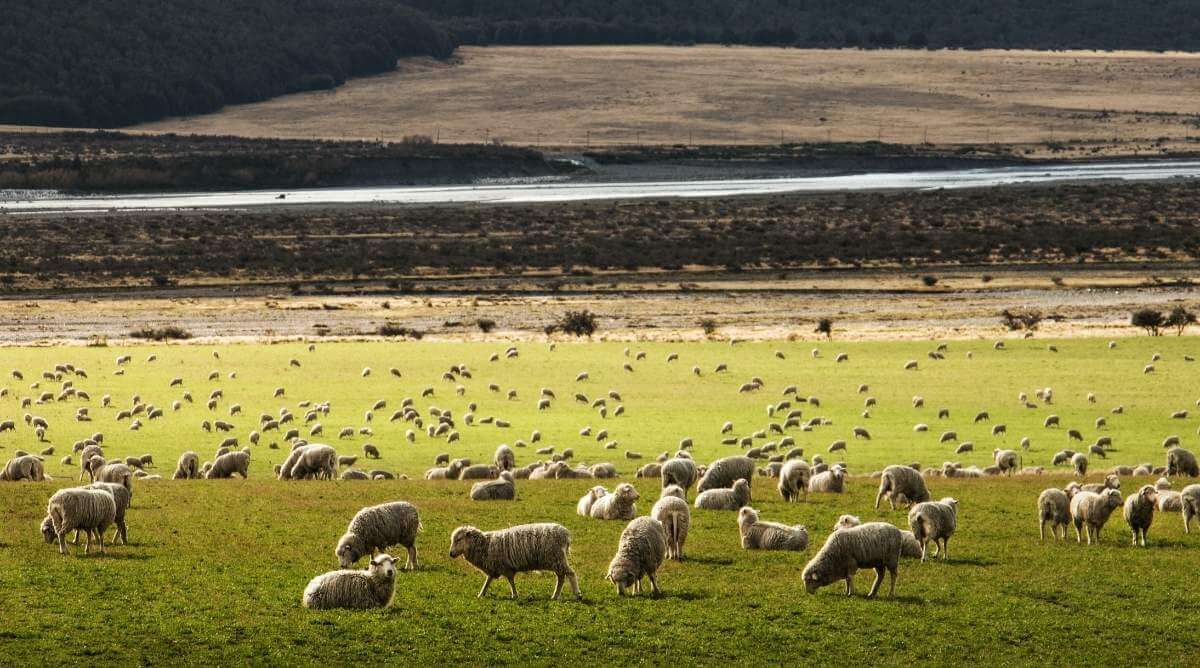Rambouillet sheep are self-reliant and adaptable to harsh environments and climates. Their tendency to stick together in flocks helps them in large open spaces and ranches. They are a dual-purpose wool and meat breed known to be docile, making them ideal for the sheep industry.
Table of Contents
Origin of Rambouillet Sheep
Rambouillet sheep were bred from a select few hundred of the finest Merino sheep from Spain in 1786 and 1799 by the French government at its national sheepfold at Rambouillet, France.
Rambouillet sheep were introduced to the United States in 1840, where they thrive on the western ranges.
Rambouillet Sheep Characteristics
The Rambouillet is considered one of the top breeds of fine wool sheep.
It’s the largest fine wool sheep, and is a dual-purpose breed well known for its wool and meat. It has a white face and white legs. The wool around the Rambouillet sheep’s face can become heavy and cause wool blindness. This problem has largely been solved through selective mating practices.
Rambouillet rams have spectacular horns that curl near the head or away from the face. Rambouillet ewes are most often polled or without horns.
Rambouillet sheep have a calm temperament and interact well with humans, mainly keeping to themselves. They do not display aggressive traits and rarely fight.
| Characteristics | Description |
| Origin | France |
| Appearance | White face and white legs. Rams have impressive curved horns. Ewes most often have no horns. |
| Weight | 250-300 pounds (Rams), 150-200 pounds (Ewes) |
| Wool | Bright cream or white. Uniform, dense, and high yielding. The staple averages 4.5 inches (mixture of long and fine staples). An average fleece yield 35-55%. Fine fiber of 18.5 to 24.5 microns. |
| Fertility | Lengthy breeding phase. Lambs grow fast. |
| Meat | Not high quality meat. Crossbred with other breeds to improve flavor profile. |
| Other attributes | Calm temperament. Strong flocking instincts. |
| Common uses | Wool production. |
Rambouillet Breeding & Fertility
Rambouillet sheep offer commercial farmers an above-average growth rate higher than many small fine wool breeds. The lambs grow fast under good feeding conditions. They produce satisfactory market weights from six to nine months of age.
The Rambouillet breed has a lengthy breeding phase which is sought after by farmers in the commercial space. The characteristic makes the ewes a solid foundation for crossbreeding programs.
What Is the Quality of Rambouillet Sheep Wool?
Wool production is one of the primary uses for Rambouillet sheep and a significant reason for farming or breeding them.
The fleece of the Rambouillet sheep breed ranges from bright cream to white. It is uniform, dense, and high yielding. The staple is on average 4.5 inches and is a mixture of long and fine staples. An average fleece should have a yield of 35-55%. The fiber is fine, measuring between 18.5 to 24.5 microns.
Most people are comfortable wearing the resulting fabrics directly against their skin.
Fibers spun from Rambouillet sheep wool are often used for babywear, for garments worn close to the skin, and as a blend with other exotic fibers.
What Kind of Meat Do Rambouillet Sheep Produce?
While the Rambouillet is renowned for its high-quality wool, it also produces meat.
However, it isn’t high quality meat. Rambouillet sheep have meaty bodies, but its yields of edible or saleable meat are low. Rambouillet sheep are often crossbred with other breeds to increase and improve the flavor profile of the meat produced.
At maturity, Rambouillet rams can reach weights between 250 and 300 pounds, while the ewes can hit weights of 150 to 200 pounds.
What Environments Are Best for Rambouillet Sheep?
Rambouillet sheep are hardy animals that thrive in most climates and perform well on sub-par pastures. It is still essential to provide proper pasture rotation and good quality feed. In the Western United States, they are one of the most common breeds of sheep.
Their flocking instincts are strong, which is beneficial if you raise them on an open range.
American Rambouillet Sheep Breeders Association
Established in 1889, the mission of the American Rambouillet Sheep Breeders Association is to promote the purity of the breed of the Rambouillet sheep.
The headquarters for the association can be found in Hawley, Texas.

